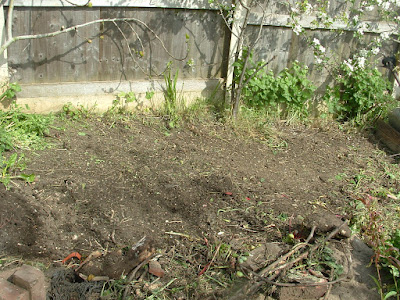I'm in the middle of my seed sowing extravaganza which started slowly last month but has been ramping up steadily since. Quite a lot of the early seeds are now little seedlings: broad beans, peas and snap peas have all popped up at the allotment (a bit patchy but good enough) and tomatoes, some brassicas and onions/leeks (and more) are all in seed trays at home, both indoors and out. I've even transplanted a row of chamomile seedlings up at the allotment.
When I sow seed trays I generally broadcast the seed over the top and unless the packet says not to cover, I'll scatter them over with a thin layer of crushed eggshells; these are air dried first and are fairly easy to break up by hand if necessary, though I generally tip them in a bucket and smash them with whatever hand tool is nearby (rake, mallet, trowel, etc) or even my shoe. Some seed packets give instructions to cover with a layer of vermiculite and I find the eggshells are an acceptable substitute: seedlings are excluded from light and seem to poke through just fine.
I stopped using modules for most seeds; in my own personal experience the seedlings are smaller when sown in them compared to the seed tray. However, it's imperative that seedlings are pricked out of the seed tray before they grow much, or they will be in danger of stunting--and therefore underperforming. This weekend I filled two deeper seed trays and pricked out a few dozen kohl rabi seedlings from their original tray. I picked the ones with the biggest seed leaves, which were growing their first true leaf; these I gently teased out with the help of a wooden skewer and replanted into the deeper tray about 3-4 cm apart. I gently watered them in and will keep them slightly moist until they grow big enough to transplant later this month. The smaller or slightly deformed seedlings I discarded after pricking out the big ones (these aren't usually worth growing, as they will be too small to harvest). I sowed the seed trays outside to save on the hassle of hardening off which I would have to do if I sowed them indoors (they don't need much heat to germinate, unlike some seeds).
I do use individual "modules" for runner beans and other climbing beans (though not for peas) as they don't transplant well: I save toilet paper tubes and make similar sized tubes out of newspaper sheets for these and then just pop the paper tube right into the ground when planting out. I've tried pre-sprouting them as for peas (a handful of seeds into a bag of wet compost till they sprout) but the bean seeds haven't performed well for me like this; maybe because I start the peas much earlier in the year before the pests are very active? Not sure, but I would rather have 30 bean plants transplanted than 100 seeds fail to come up at all. I also start pumpkins, zucchinis, etc in individual pots for the same reason. These seeds, and tomatoes and sweetcorn and the like are all sown indoors.
Now just a few plants will go on to be potted on after pricking out; my tomatoes were pricked out into trays last month, and are growing well enough on my kitchen windowsill to be potted on--it's way too early to transplant them outside but I want them to keep on growing bigger until I can in mid to late May. These I will pot on into their own pots in my rich homemade compost mixed with a bit of sand (or finely crushed eggshells if the sand runs out). I may have to pot them on again into bigger pots, depending on how well they grow: here's hoping!


